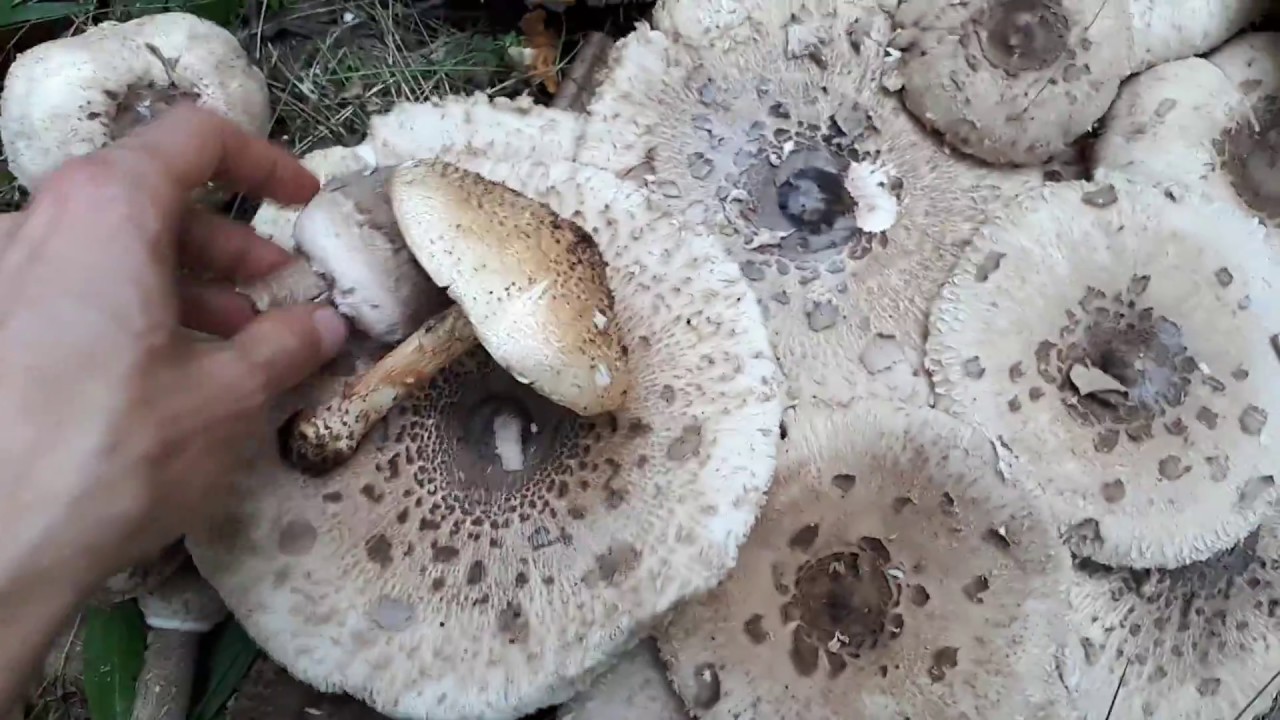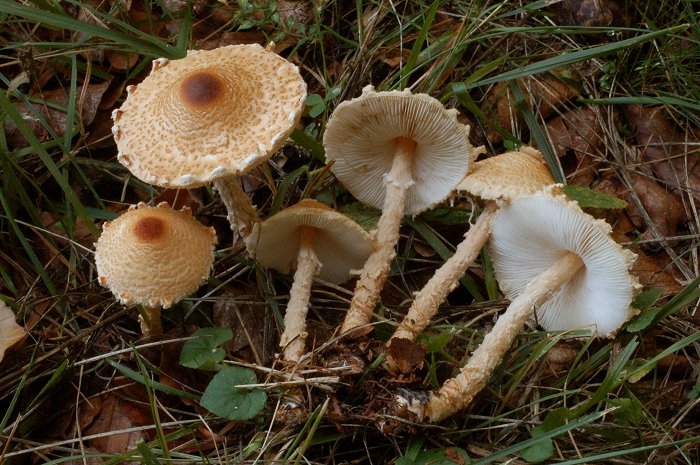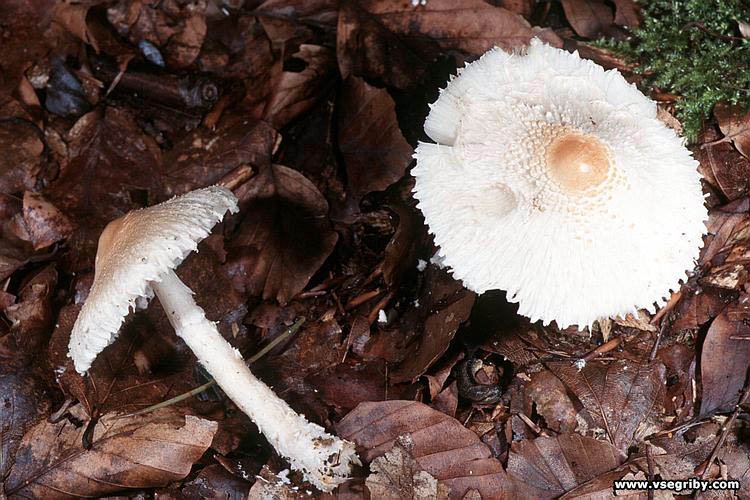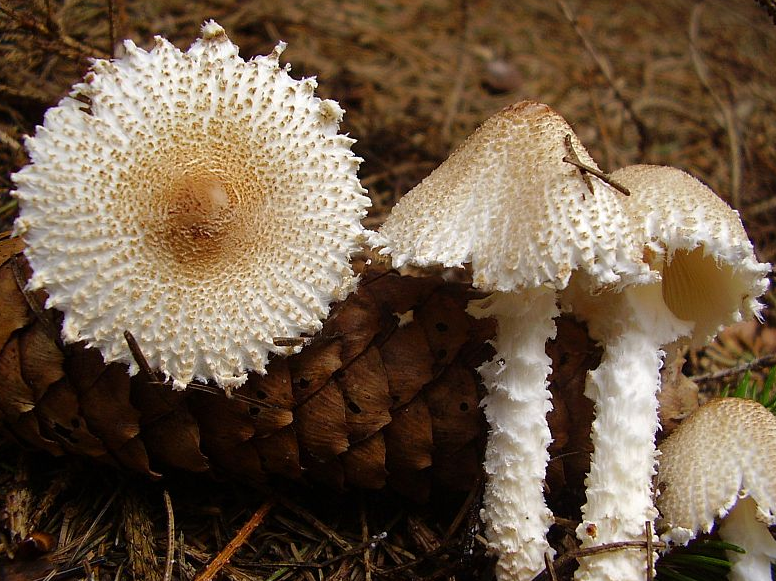Description of the poisonous lepiota
The shape of the cap of the poisonous lepiota is rounded, while a barely noticeable tubercle is visible in the center. There are very thin radial grooves on the surface of the cap. The color of the cap is gray-red. Its surface is matte with a silky sheen. The hat is covered with a large number of pressed scales. Its diameter does not exceed 2-7 centimeters.

The leg is low, central, cylindrical in shape. There is no thickening in the leg. Inside, it is hollow, fibrous. The color of the leg is pink. Its height is 2-4 centimeters. There is a very fragile whitish ring on the stem, which often falls off.
The plates are concave, often located. The pulp is white, slightly pink at the cut. The pulp has a sweetish smell, but it is tasteless. Spores are white.

The variability of the poisonous lepiota
The color of the cap of the poisonous lepiota varies from pink to brick red. The color of the plates is cream or white. The stem can be pink or reddish brown.
Places of growth and season of poisonous lepiota
Poisonous Lepiota can be found from June to August. These mushrooms grow in Western Europe and Ukraine. They settle among the grass - in meadows and in parks.

Similar species
Poisonous lepiota is outwardly similar to other types of small lepiots. All small lepiots should be viewed with great suspicion.
Toxicity of Lepiota Poisonous
This is an extremely poisonous mushroom, to be more precise, a deadly poisonous species. The only good news is that these mushrooms look frail and unsightly, and are small in size, so they do not attract mushroom pickers.

Other mushrooms of this genus
Swollen lepiota or swollen umbrella is a poisonous mushroom. His hat is small, measuring 3-6 centimeters. With age, it changes from hemispherical to prostrate, while maintaining a characteristic tubercle. The color of the cap is beige, white-yellow or reddish. The surface of the cap is dotted with scales. The pulp is yellowish with a pleasant mushroom aroma. The leg is quite thin - its diameter does not exceed 0.5 centimeters, and its length is 5-8 centimeters. There is a ring on the leg, but it quickly disappears.
Lepiota swollen rare mushroom. These mushrooms bear fruit from August to September. They grow in different types of forests. Most often found in small groups.

Lepiota Bradisson is a poisonous mushroom. Immature mushrooms have conical caps with a diameter of 2-4 centimeters, but as they mature, they become open. The cap has a well-visible brownish-red tubercle. The surface of the mushroom is covered with a white skin dotted with sparse brown scales. The shape of the leg is cylindrical. The color of the leg is fawn, and the base is purple-violet. The height of the leg reaches 5 centimeters, and the diameter is up to 0.5 centimeters. But the leg has a fragile ring.
These mushrooms grow not only in forests, but also in steppes, parks, glades, and forest plantations. Lepiota Bradisson begins to actively bear fruit in the fall.
Where it grows and when to collect
Where can you find this mushroom? The rough umbrella is very fond of settling in humid places. Preferably, in the swamp area. He is very fond of mixed forests. It is a saprotroph.
Basically, they prevail on humus soil, as well as in places where there is rotten debris or leaves.
It is somewhat less common along highways and roads, on lawns and in parks.
It grows, as a rule, in groups, so if you find a couple of representatives of this species, be careful, there will certainly be more around.
Loves shady places and just hates sunlight. Therefore, you are unlikely to find it in open meadows or forest edges. However, if for some reason the mushroom is exposed to the sun's rays, then its cap will begin to crack very quickly and become unusable. The mushroom dries quickly in the sun and mummifies.

Photo - MJ.
Where can you find rough lepiota?
The scaly umbrella is most common in Russia and other CIS countries: Belarus, Ukraine, and so on.
The most widespread was in central Russia. Also, mushrooms have been seen in Western Europe, North Africa and North America.
Loves moderate climatic zones, does not survive in bright sun conditions. If the summer is hot, the lepiota may hide and not grow at all.
Active maturation of this mushroom occurs from the very beginning of August and lasts until mid-October. The fungus demonstrates the most active growth during the period of leaf fall.
Related article - Umbrella Mushroom Variegated: edible and 5 types of dangerous doubles with a photo.
Areas of growth of lepiota are brown-red.
These poisonous mushrooms live in beech forests, gardens and parks. They love cultivated land. Lepiots grow brown-red in groups or individual specimens. Fruiting is observed in the autumn.

This is a rare type of mushroom. Brown-red lepiots are widespread in Sweden, Poland, Germany, Denmark, Switzerland, France, Austria, Slovakia, Estonia, Ukraine, Central Asia, Morocco, Algeria and the British Isles.
Poisoning with brownish-red lepiota.
Brown-red lepiota is one of the most dangerous types of mushrooms. It can be fatal. The fruiting bodies of brown-red lepiot contain nitriles and cyanides. These substances are incredibly dangerous because there are no antidotes against them. Cyanides cause damage to the central nervous system and the brain. And nitriles provoke respiratory paralysis.

Symptoms of brown-red lepiota poisoning appear within 15 minutes after eating the mushrooms. White foam is released from the victim's mouth, this is due to a massive rupture of the alveoli of the lung tissue. In half an hour, cardiac arrest may already occur, and as a result, death.
The first cases of poisoning with brown-red lepiots in our country were recorded in 1966. A 13-year-old girl was poisoned, her temperature rose, her body became covered with blue spots, persistent vomiting opened, and after 2 days she died.

Related species of lepiota are brownish-red.
Crested lepiota is also poisonous. The shape of its cap is convex or flat-convex. The color is whitish, red-brown scales are located on the surface. The pulp is thin, white. Her smell is spicy, rare, and the taste is unpleasant. The leg is cylindrical, even, smooth, hollow inside, pinkish or yellowish in color. There is a filmy ring, which disappears when ripe.
Crested lepiota grows in deciduous forests and conifers, as well as in meadows, vegetable gardens and pastures. Fruiting occurs from July to October.

Shield lepiota is a conditionally edible relative of brown-red lepiota. The cap is bell-shaped at a young age, then its shape becomes flattened, and a distinct tubercle is noticeable in the center. The surface of the cap is white with a large number of woolly small scales, which eventually become ocher brown. The leg is thin, white or brown in color, hollow inside. On the leg there is a woolly blanket and a filmy ring, which disappears over time. The pulp is soft, with a fruity aroma and sweet taste.

Lepiots grow in deciduous forests and conifers. Fruiting from summer to autumn. They usually settle in small groups. They are rare. In certain years, fruiting is quite active.
Theolepiota golden (Phaeolepiota aurea)
- Other names for the mushroom:
- Golden umbrella
- Mustard plaster
- Herbal flakes
Synonyms:
- Agaricus aureus
- Pholiota aurea
- Togaria aurea
- Cystoderma aureum
- Agaricus vahlii

Description of the mushroom
The cap is 5-25 cm in diameter, in youth from hemispherical to hemispherical-bell-shaped, with age it becomes convex-prostrate, with a small tubercle.The surface of the cap is matte, grainy, of a bright golden yellow, ocher yellow, ocher color, an orange tint is possible. The edge of the cap of mature mushrooms may have a fringed remnant of a private bedspread. The granularity of the cap is more pronounced at a young age, up to scaly, with age it decreases, up to disappearance. At a young age, along the edge of the cap, at the place of attachment of the private bedspread, a strip of a darker shade may appear.
The pulp is white, yellowish, may be reddish in the stem. Thick, fleshy. Without any special smell.
The plates are frequent, thin, curved, adherent. The color of the plates ranges from whitish, yellowish, pale ocher, or light clay at a young age, to rusty brown in mature mushrooms. In young mushrooms, the plates are completely covered with a dense filmy private veil of the same color as the cap, possibly a slightly darker or lighter shade.
Spore powder, rusty brown. Spores are oblong, pointed, 10..13 x 5..6 μm in size.
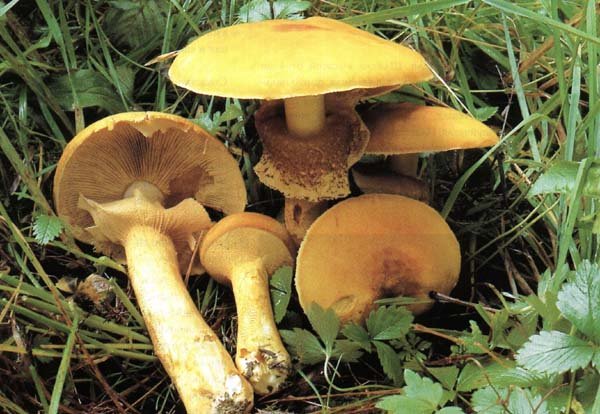
The leg is 5-20 cm high (up to 25), straight, with a slight thickening at the base, possibly widened in the middle, granular, matte, longitudinally wrinkled, at a young age smoothly turning into a private veil, also granular, radially wrinkled. At a young age, the granularity is very pronounced, up to scaly. The color of the leg is the same as that of the coverlet (like the cap, possibly of a darker or lighter shade). With age, the veil breaks, a wide, hanging ring remains on the leg, the color of the leg, with brown or brown-ocher scales, which can cover almost, or even the entire area, giving the veil a completely brown appearance. With age, towards the old age of the fungus, the ring decreases noticeably in size. Above the ring, the leg is smooth, at a young age, light, of the same color as the plates, there may be whitish or yellowish small flakes on it, then, with the maturation of the spores, the plates begin to darken, the leg remains lighter, but then it also darkens, reaching the same rusty brown color as the plates of the old mushroom.
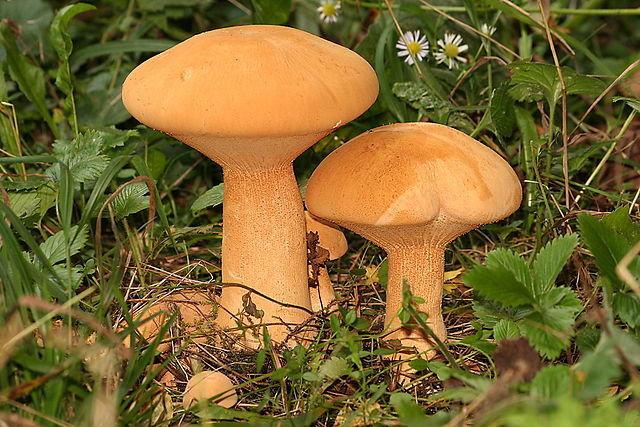
Habitat
Theolepiota golden grows from the second half of July to the end of October, in groups, including large ones. Prefers rich, fertile soils - meadows, pastures, fields, grows along roads, near nettles, near bushes. Can grow in clearings in light deciduous and larch forests. The mushroom is considered rare, it is listed in the Red Book of part of the regions of Russia.
Similar species
This fungus has no similar species. However, in the photographs, when viewed from above, the pheolepiota can be confused with a ringed cap, but this is only in photographs, and only when viewed from above.
Edibility
Previously, golden pheolepiota was considered a conditionally edible mushroom, which is eaten after 20 minutes of boiling. However, now the information is contradictory, according to some reports, the mushroom accumulates cyanides, and can lead to poisoning. Therefore, recently, it is ranked among the inedible mushrooms. However, no matter how much I tried, I did not find information that someone poisoned them.
Photo: from the questions in the "Identifier".
Where do chestnut lepiots grow
Judging by the name, it can be assumed that you need to look for lepiots under the chestnuts. This is a wrong judgment. You can meet the chestnut umbrella under deciduous trees, although it is also found in mixed forests. It can often be seen in the garden, ditches, along the roadside.
Umbrellas grow in Russia almost everywhere, except for the Far North. The growth of fruiting bodies begins with the appearance of grass in early spring. Fruiting lasts all summer, autumn, up to frost.
Attention! The chestnut umbrella has no counterparts, but it is very similar in appearance to the deadly poisonous brown-red lepiota. She has a hat that is almost the same in shape, only its color can be grayish-brown, brown-cream with a tint of cherry
The edges of the cap are pubescent, dark scales are arranged in circles
She has a hat that is almost the same in shape, only its color can be grayish-brown, brown-cream with a cherry tint. The edges of the cap are pubescent, the dark scales are arranged in circles.
The pulp is white, near the leg of a creamy shade, below it is cherry. Young lepiots are red-brown and smell like fruit, but as they mature, the stench spreads from them.
A warning! Lepiota red-brown is a deadly poisonous mushroom, from which there is no antidote, since the central nervous system is affected by poisoning.
Poisonous Umbrella Mushrooms
Among the numerous genus Macrolepiota, there are specimens that almost do not differ from the edible in appearance, but are considered poisonous. These include the umbrella comb, chestnut, fleshy red, brownish red and rough. The most dangerous are the first 2 types.
Chestnut
Chestnut lepiota has a red or brown head, the diameter of which does not exceed 4 cm. The head of the chestnut umbrella mushroom at a young age has an ovoid shape, then takes the form of a prostrate dome. A small tubercle remains in the center. Gradually, the skin of the cap cracks, small scales and brownish color are formed.
As the plates grow, they turn yellow. The reddish or brown flesh is highly fragile and has an unpleasant odor. The leg is in the form of a narrow cylinder, expanding closer to the base. The ring is white, but gradually becomes thinner and disappears completely.
The chestnut umbrella is very poisonous, in most cases the use of this product in food is fatal.
Comb
The hat of young umbrellas is bell-shaped, later becoming like a wide dome up to 10 cm in diameter. Its surface is red-brown or dark brown, covered with orange or yellow scales with sharp tips.
The leg in the upper part is cylindrical, hollow, thin, 7-10 cm high and no more than 5 mm in diameter. It differs in a variety of tones - from yellow to cream, but it can also have a brown tint. In young specimens, a wide membranous ring is clearly visible, white or pink, but quickly disappears as it grows.
The pulp of the mushroom is white, has an unpleasant odor and taste.
Crested lepiota is a poisonous species and is not eaten.
Rough
The cap of a scaly lepiota is capable of reaching 15 cm in diameter, bell-shaped. As they grow older, it becomes prostrate or convex, with a wide tubercle in the central part. The surface of the cap is very dry, reminiscent of felt. Color - from yellowish to light brown. The scales are darker, pyramidal, and large.
The blades of the umbrella mushroom are under a white blanket, which later transforms into a thin, white, cobweb ring with brown scales on the lower part. The color of the plates is from white to cream.
The stem, which has a tuberous shape at the base, is thin (10-15 mm) and long (up to 12 cm), hollow. Above the ring it is distinguished by a light shade, under it - yellow or brownish, fibrous, covered with scales, cylindrical in shape.
The pulp of Lepiota rough has an unpleasant, strong resinous odor and a bitter taste. Not used for food.
Belonavoznik Bedham: where it grows and what it looks like
| Name: | Belonavoznik Bedham |
| Latin name: | Leucocoprinus badhamii |
| Type of: | Inedible |
| Synonyms: | Leucobolbitius badhamii, Mastocephalus badhamii. |
| Specifications: | |
| Systematics: |
|
Bedham's wormwood (Leucocoprinus badhami) is a lamellar mushroom from the Champignon family and the genus Belonavoznikov (Leucocoprinus). Its other names:
- leucobolbitius, named by the Danish mycologist and politician Jacob Lange in 1952;
- mastocephalus is the name given to the mushroom by the Italian Giovanni Battarra in 1891.
It was first described and classified in 1888 by Narsis Patouillard, a French pharmacist and mycologist.
Where does Bedham's whitehead grow
The Belonavoznik Bedham is a rare species with an unusually wide range of distribution. In Russia, it can be found in the foothills of the Caucasus, in Udmurtia and Tatarstan, in the southern regions and Primorye.
Feels great in hotbeds and greenhouses, on piles of rotten debris and humus. It is found in deciduous and coniferous forests with an abundance of windbreaks and forest litter, in gardens, parks and in personal plots. Loves wet places, river floodplains, damp ravines and gullies. It settles in small, closely spaced groups, rarely singly. The fruiting period is from August to November, until persistently cold weather.
This type of fruiting bodies loves humus-rich alkaline soils and deposits of plant remains, warmed up due to decay processes
What does Bedham's white hatchback look like?
Only the fruiting bodies that have appeared have ovoid, spherical caps. Growing up, they first expand into a rounded dome, then transform into an umbrella with a noticeable spherical bulge at the top. Adult specimens have a prostrate shape. The edge is thin, often cracks and breaks off. The diameter of the cap is from 2.5-3.5 to 5-7 cm.
The surface is dry, velvety, matte. White, with small, densely appressed scales of a brownish-rusty color, denser at the apex. The color may change to a creamy gray.
The plates of the hymenophore in young specimens are covered with a dense cape, which, with age, remains on the edges of the cap and leg. They are frequent, not accreted, of equal length, distinctly separated from each other. White, creamy pinkish, with age they become saturated red. The spore powder is white, yellowish or creamy, and the pores themselves are colorless.
The stem is straight or slightly curved, thin and long, with a distinct ring closer to the cap. The surface is dry, covered with white down to the ring. Above is unpuffed. The length varies from 3-5 to 8-11 cm, with a diameter of 0.4 to 0.9-1.7 cm. The color is white, above the ring it is brownish-beige.
The pulp is thin, fragile, watery, pure white. Has a mushroom or unpleasant putrefactive smell.
Closer to the root, the leg of the mushroom expands noticeably
Is it possible to eat the Belonavoznik Bedham
The fruit body is an inedible species. There is no exact data on its toxicity, according to some sources it contains substances hazardous to humans.
Conclusion
Bedham's whitehead is a rare, widespread species of lamellar mushrooms. Belongs to the Champignon family and the Belonavoznikov family. Inedible, possibly toxic. It is a saprotroph, settles on rich fertile substrates, in humid lowlands. On the territory of the Russian Federation, it is found in the Rostov Region, in the Stavropol Territory, in Udmurtia and Tatarstan. It can also be found in North America and Europe. The mycelium bears fruit from August to October. Grows in small groups in deciduous and coniferous forests, parks and gardens, on overheated manure.
Description of pink lepiota
The hat of a pink lepiota has a diameter of 2-5 centimeters, in shape it is convex-outstretched or flat-outstretched. The edges of the cap are slightly curved inward. Her color is ocher pink. The surface of the cap is completely covered with tightly pressed scales. The color of the plates is wine-brown.

Lepiota rosea is a lamellar fungus. The plates are free, very frequent, wide. The color of the plates is cream with a slight greenish tinge. The pulp is firm. The color of the flesh of the cap and the upper part of the leg is creamy, and the lower part of the leg is meat-colored
The stem of the serrated umbrella is cylindrical, of average length - 2.5-4 centimeters and up to 0.35 centimeters in diameter. There is a characteristic fibrous ring in the middle of the leg. Above the ring, the leg is light gray, and the lower part of it is dark gray.

Outwardly, lepiots are very similar to umbrella mushrooms, but are smaller in size. And the rest of the generic characteristics (a cap that looks like an open umbrella, fibrous scales and a motionless ring on the stem) in these fungi completely coincide.
Places of distribution of serrated umbrellas
Serrated umbrellas are common in Western Europe: France, Belgium, Italy, Denmark, Hungary, Germany, Great Britain, as well as in Russia and Kazakhstan. These mushrooms grow among the grass, in the meadows. An active growth of pink lepiota is observed from mid-June to late August. Lepiots are saprophytes, meaning they feed on decaying debris in the soil.

Toxicity of pink lepiota
In no case should you taste this mushroom - pink lepiota is a deadly poisonous species, it contains cyanides that provoke serious poisoning.
Similar species
There are about 50 species in the genus, with 7 species being classified as poisonous, and 3 as deadly poisonous, and there are also little-known edible species in the genus, for example, the small thyroid umbrella. But lepiots are very difficult to distinguish, and since there are deadly poisonous species in the genus, it is recommended not to collect these mushrooms at all.

Related species
On the territory of Russia and Europe, species such as
- Chestnut Lepiota has a cap with a diameter of 2-4 centimeters. At first, its shape is almost ovoid, and over time it becomes flat. The color of the cap is yellow-brown or red-brown with chestnut-colored felt scales. The leg length is 2-5 centimeters. These mushrooms bear fruit from July to September. They grow in forests, gardens, along ditches. They are not common. They settle in groups.
- Lepiota poisonous has a rounded cap with an unexpressed tubercle. The color of the cap is gray-red. The surface of the cap is matte with a large number of pressed scales. The leg is low, cylindrical, pink in color. It has a very fragile whitish ring. These mushrooms are found from June to August. They grow in Western Europe, Ukraine. You can find them among the grass in meadows and parks. This is a rare species. It bears fruit exclusively in autumn.
- Rough lepiota, comb lepiota, swollen lepiota and thyroid lepiota are highly suspicious of toxicity;
- Red-leaved leptiota is an edible fungus;
- Scallet lepiota is classified as conditionally edible mushrooms that are suitable for frying and boiling.

Medicinal properties and medicine
The rough umbrella, according to scientists, has good antibacterial and antiseptic properties. An extract is obtained from these mushrooms, which is very effective in combating various intestinal diseases and bacteria. For example, it is used in the fight against E. coli or hay bacillus.
This fungus has recently been found to have anti-cancer properties. Its extract helps to inhibit the growth of Ewing's sarcoma.
Therefore, people who suffer from oncology, but still have not lost hope, go to collect these mushrooms in the places of their greatest accumulation. Having collected a large enough amount, decoctions and infusions are made. Despite the awful taste and no less awful smell, they eat several tablespoons a day.
Unfortunately, in some, the body cannot cope with such an unpleasant taste and smell, therefore, naturally, the treatment fails. Others note that they are able to slow down the growth of neoplasms and metastases.
Alcohol and lepiota rough
For a long time it was believed that despite the unpleasant taste and smell, this mushroom cannot harm humans.
So they thought for a long time, until in 2011 German toxicologists conducted the corresponding studies. On the fact of analyzing and studying the properties of the fungus, an article was published, where terrible cases were told when the use of rough lepiota led to coprinous syndrome.
Despite the fact that in fact the study of coprin in the mushroom was never found, a negative effect on the body was still identified. Especially when drinking alcohol.
So, German scientists cite data that cases were recorded when as many as five patients were poisoned with fried mushrooms, namely rough lepitis. Each poisoned person assured that every time he ate this dish, and there were never any problems. However, during research and interviews, it was found that such a reaction occurs only after people have taken alcoholic beverages.
Immediately after the drink was taken, the patients felt a strong reddening of the face. A severe throbbing headache set in. Breathing stopped short and intermittent, tachycardia occurred.
In such a state, people urgently went to a medical institution. With the right help, the symptoms disappeared after a few hours. However, with repeated consumption of alcohol, they occurred again. This happens until the lepiota and its substances are completely eliminated from the body.
What else is remarkable about rough lepiota?
Description of lepiota rough
The appearance of this mushroom is really memorable. Having seen him once, you definitely will not confuse him with many other representatives of mushrooms, but still, you will be careful not to rip off his poisonous counterparts.
Hat
The cap of this mushroom is bell-shaped. However, in this state, she does not stay long. Already a month after the moment the mushroom emerged from the ground, the cap takes on an umbrella-shaped shape. At the same time, a bump begins to protrude strongly in the very center. The diameter of the cap varies depending on the growing conditions and depending on the age. It varies from 5 to 10 cm. The color of the cap is rusty-brown. If you look closely at the surface itself, you will notice that it is gray with white and dark brown blotches. If you run your finger over the cap, you can feel that it is all covered with bristles, or otherwise pointed pyramidal scales. The older the mushroom, the darker shade of scales we can observe.
Let's take a look under the hat. Sharp scaly plates are hidden under it. They are very wide, loose and often spaced. It is believed that they add volume to the mushroom cap. When pressed, they begin to turn brown. The hat is also fleshy, has a white tint on the cut, but when interacting with oxygen, due to the high content of amino acids, it acquires a yellowish tint.
Leg
The stem of this sharply scaled mushroom is even and cylindrical. Its length also depends on the age and place of growth. It reaches a length of 8 to 15 cm. Its diameter is small, in relation to its height, only from one to one and a half cm. The base is slightly swollen, but very dense. The leg is more yellow below, and becomes white at the junction with the cap. Depending on the characteristics of the soil and the place of growth, the leg at the base may acquire a brown tint.
In structure, it is scaly fibrous.

Photo by Drew Parker.
In the very center of the leg there is a ring and a skirt. It is wide enough, but at the same time very thin, almost transparent. Has a film structure. The bedspread is cobweb and has a white cream shade. Sometimes there are ocher blotches on them.
The flesh at the leg is rather loose, but at the same time white. The smell is not the most delicious and pleasant, rather more disgusting.
Edibility
As mentioned above, this spiky-scaled umbrella refers to an inedible mushroom. It has a very unpleasant odor that resembles rot. Bitter taste. Decoctions of these mushrooms are distinguished by a strong resinous aroma, and sometimes even altogether, resemble burnt plastic.
Lepiota that grows on the territory of Russia and the CIS countries is really not poisonous, although not edible. However, mushrooms, which also have the name "scabrous lepiota", but growing in Europe and North America, according to foreign researchers, are deadly poisonous due to the peculiarities of the soil and the local climate.

